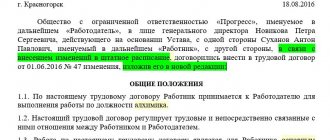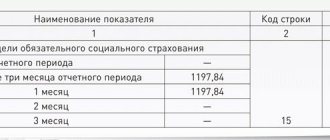Length of working hours per week
Currently, the state is guarding a reasonable combination of work and rest, and it strictly sets the maximum length of the working week.
IMPORTANT! The length of the working week for all categories of workers cannot exceed 40 hours (Article 91 of the Labor Code of the Russian Federation).
Varieties of the work week:
- five days with 2 days off;
- six days with 1 day of rest;
- working week with days off on a rotating schedule;
- part-time work week.
The length of the working week in conjunction with other labor parameters (start and end times of the working day, duration and schedule of regulated breaks, number of work shifts, alternation of working days with rest days, etc.) is established by internal labor regulations, collective agreement and other legal regulations (Article 100 of the Labor Code of the Russian Federation).
The working week has a similar length not only in Russia, but also in other countries. The 40-hour work week occupies a middle position in the range of countries with a longer or shorter working week. For example, in China the working week lasts 60 hours, in Japan - 50, and in Finland only 33.
For schoolchildren
The length of the working day (shift), as we have already found out, is established to one degree or another for certain categories of persons. In the case of the media, everything is clear - there, basically, the employer himself dictates his own rules, but taking into account the established weekly labor norm. But what if we are talking about minors?
In this case, the maximum allotted to the employee is 5 hours a day. But this is only for workers under 16 years of age. After this restriction, you can work a maximum of 7 hours a day until you reach adulthood. By the way, it is important to understand here that the employee does not have to be trained. Otherwise, during the study period, they can work in shifts of 2.5 and 3.5 hours per day, respectively. This is exactly what a working day (duration) can be. The Technical Regulations of the Russian Federation indicate that no one has the right to leave minor employees to work part-time, even overtime. In any case, while studying in educational institutions.
Women's work week
Women belong to a separate category of workers, especially protected by law. Various benefits and relaxations in work and rest regimes are provided for them. The length of the working week (WW) is one of the adjustable elements of women’s work.
A shortened working week for women is discussed not only in the Labor Code, but also in other legal acts.
For example:
- Art. 320 of the Labor Code of the Russian Federation determines the possibility of establishing a work permit lasting 36 hours for women performing labor functions in the regions of the Far North and equivalent areas;
- Resolution of the Supreme Council of the RSFSR dated November 1, 1990 No. 298/3-1 “On urgent measures to improve the situation of women, families, maternal and child health in rural areas” established a 36-hour working week for women working in rural areas with the same salary as in full weekly work (40 hours).
For women with children, the state provides benefits for the duration of RN:
- if children are under 1.5 years old;
- for older children (up to 14 years old).
In relation to the first category - nursing mothers - the law does not provide for a direct rule on a reduced pH. However, the RN of this category of workers still has a reduced duration due to the provisions of Art. 258 of the Labor Code of the Russian Federation additional breaks for rest and nutrition. At the request of the woman, these breaks can be transferred to the end of the working day, which reduces the 8-hour working day by an hour. A break to feed a child is paid in the amount of average earnings.
If a woman has an older child (under 14 years of age), then, upon her application, a part-time working day can be established at the normal duration of the RN with payment in proportion to the time worked.
Get acquainted with the legally established guarantees for women with children from the materials on our website:
- “Assignment and payment of child care benefits up to 1.5 years old”;
- "Children's benefits have been indexed."
Shortened working week for teenagers, harmful people and disabled people
The working life of the younger generation is marked by a shorter working week. In this case, the duration varies depending on age and cannot exceed:
- 24 hours - for teenagers under 16 years old;
- 35 hours - for the working young generation aged 16 to 18 years;
- 17 hours - if a minor worker simultaneously receives secondary education.
If the company’s employees are exposed to unfavorable factors when performing their work functions, the duration of the RN should be less than the legally established 40-hour norm.
Study dangerous and harmful production factors with materials from our website:
- “Dangerous and harmful production factors (list)”;
- “What refers to harmful working conditions (nuances)?”
The time frame for RN in this case is as follows:
- no more than 36 hours - if employees come into contact with dangerous and harmful factors;
- no more than 24 hours - if workers work with dangerous chemicals or weapons.
The reduction in the working week of this category of workers is dictated by the need to preserve their health under the influence of unfavorable conditions during work.
For members of the workforce whose health and ability to work have already been partially lost (disabled people of groups 1 and 2), the duration of the RN is also set in a shortened version. They are required to work no more than 35 hours a week.
Professional work week
Representatives of certain professions are required by law to reduce the length of the working week.
For example:
- for teachers, RN is established for a duration of no more than 36 hours (Article 333 of the Labor Code of the Russian Federation);
- for doctors - no more than 39 hours (Article 350 of the Labor Code of the Russian Federation);
- for senior teachers of preschool institutions - no more than 36 hours;
- for teachers of 1st and 2nd grades of music and art schools - no more than 24 hours;
- for physical education teachers - no more than 30 hours;
- for crew members of civil aviation aircraft (pilots, navigators, flight engineers, flight mechanics, flight radio operators, flight operators) when performing flight work - no more than 36 hours (Resolution of the Ministry of Labor of the Russian Federation dated July 12, 1999 No. 22).
The influence of the length of the working week on the standard working hours
The standard working hours and the duration of the RN are directly related. To calculate the standard working time for RN lasting 16, 24, 33 hours, etc., a single methodology is used.
IMPORTANT! To determine the norm of working time for different durations of RN, the Procedure for calculating the norm of working time depending on the length of the working week, approved by Order of the Ministry of Health of Russia dated August 13, 2009 No. 588n, is used.
To calculate the standard working hours in a certain month, you must follow the algorithm:
- determine the duration of RN (24, 30, 36, 39, 40, etc.);
- divide the pH by 5;
- multiply the obtained result by the number of working days according to the five-day RN calendar of a particular month;
- from the result, subtract the number of hours in a given month by which working hours are reduced on the eve of non-working holidays.
Accounting
The calculation of hours worked is carried out directly by the employer . This gives him a number of advantages.
First, correctly calculate wages, subtracting weekends, vacations, and compensatory days. This leads to significant cash savings. Secondly , the manager will be able to check the whereabouts of the employee at any time and apply punishment in case of his absence. Starting from deprivation of bonuses to making up missed hours.
Let's turn our attention to another document.
This is order No. 588n of the Ministry of Health and Social Development dated August 13, 2009. It allows you to clearly regulate the number of working hours per week. According to the document, a worker must work 8 hours per day with a 40-hour work week.
Another point. What if a worker works 48 hours a week? Of course, this is not legal, but Order No. 588n allows you to calculate the length of the working day.
Accordingly, the number varies from 24 to 40. Divide the required number by 5 and multiply by the number of working days per month. However, there is one more nuance. From the resulting number, subtract the number of hours that fall on shortened working days.
ATTENTION! Article 95 of the Labor Code of the Russian Federation states that working hours on a pre-holiday day are reduced by an hour.
It should be noted that time tracking can be of three main types: by day, by week, or combined. Let's look at each in more detail:
- Accounting by day. Convenient when working hours are regulated. It doesn't change from day to day. By the way, many companies in Russia adhere to this schedule. Any overtime is paid as overtime.
- Accounting by week . Most often used with a flexible schedule (Article 102 of the Labor Code of the Russian Federation). According to it, the employee can independently choose the beginning and end of the working day, as well as its duration, by prior agreement with the employer.
- Combined . Used in the case of a shift schedule (Article 103 of the Labor Code of the Russian Federation) or a rotational schedule (Article 300 of the Labor Code of the Russian Federation). In this case, it is not possible to count working hours per week. Usually this is several months, 10, 20 or more days.
The calculation is largely influenced by the specifics of work at a particular enterprise. Moreover, the total working time cannot be more than 40 hours per week.
The employer records absolutely all time parameters. This applies to any work schedule, as well as overtime. Moreover, the employee can independently familiarize himself with the accounting and calculate the time worked if any questions arise regarding payroll.
Remote nuance of the length of the working week
In modern conditions, an employee has the right to work without coming to the workplace every day, that is, to work remotely. This is especially true for persons who have partially lost their ability to work and (or) have impaired body functions (disabled people).
As indicated in one of the previous sections of the article, benefits in the form of a shortened RN are provided for disabled people of groups 1 and 2. Such a feature of work activity as remote work does not deprive an employee of the right to a shortened work schedule.
IMPORTANT! Thanks to Art. 312.1 of the Labor Code of the Russian Federation, remote workers are subject to all labor legislation.
Considering that the remote worker himself determines the duration of the work shift (if the employment contract does not stipulate a specific work schedule), the employer does not bear responsibility for possible overtime - this issue remains solely the prerogative of the employee.
If the working hours are specifically defined in the employment agreement (contract), then if a remote worker has a disability of group 1 or 2, he can work no more than 35 hours a week (Article 92 of the Labor Code of the Russian Federation). At the same time, he retains the right to full payment.
The material “Unified Form No. TD-1 - Employment Contract” will help you get acquainted with the contents of the employment contract.
Weekend
Particular attention is paid to such a point as the length of the working day. A day off (or holiday) has in this regard special rules for the distribution of time for performing job duties. The point is that in such periods you are supposed to work less, although not by much.
On the eve of a holiday or non-working day, you are required to work an hour less than specified in your employment contract. Please take this into account. Thus, the allotted time is reduced. Directly on holidays, work is usually paid overtime, and the duration of this type of activity is negotiable. Or you work a full regular shift and get a weekend/holiday transfer. The alternative is full payment for overtime work.
If your work week lasts 6 days, then you should work less before the weekend. Namely, no more than 5 hours. When it comes to continuously operating organizations, all employees working on legal holidays or generally accepted days off are entitled to compensation. It has already been said about it: this is either the transfer of additional rest, or, as a rule, double pay.
Workweek thresholds
The maximum duration of the launch vehicle was discussed in the first section of the article - it is limited by Art. 91 of the Labor Code of the Russian Federation and is 40 hours.
The legislation is silent about its minimum value - the lower limit of the duration of the RN is not defined by any legal acts.
For example, you can enter into an employment contract with an employee, setting his working hours at 1 hour. It should not be forgotten that Art. 133 of the Labor Code of the Russian Federation prescribes that an employee (who has fully worked the standard working hours and fulfilled his job duties) be paid a monthly salary not lower than the minimum wage.
In the case where the duration of the work assignment is 1 hour, the minimum wage should not be lower than that calculated on the basis of the minimum wage in proportion to the time worked.
Find out everything about the minimum wage from the materials on our website:
- “In 2020 - a new minimum wage”;
- “The amount of the minimum wage for calculating sick leave (2016, 2020, 2014, 2013)”.
Results
The length of the working week is established by labor, collective agreements or other regulations. The maximum duration cannot exceed 40 hours.
A shortened working week is provided for by law for certain categories of workers (teenagers, nursing mothers, teachers, doctors, etc.).
You can find more complete information on the topic in ConsultantPlus. Full and free access to the system for 2 days.
"Special" shifts
Most often, the length of the working day is understood as so-called work shifts. They, as you might guess, will directly depend on who exactly the employee is. For example, schoolchildren are supposed to work less than adults. It's not that hard to understand.
First of all, you should pay attention to special categories of employees. Those for which the average working day (and maximum) is not established in clear values according to the Labor Code.
The thing is that some categories of workers will have to work in shifts, but the duration of time is established either by Federal laws/acts, or by a collective agreement, or by a labor agreement between the employee and the employer. But remember: the weekly norm of 40 hours should not be exceeded. Otherwise, it is either considered illegal or paid as overtime. These employees usually include:
- journalists;
- videographers;
- cinemas;
- film crews;
- workers and groups of circuses, theaters, concerts;
- other people involved in the media.









